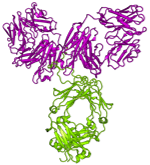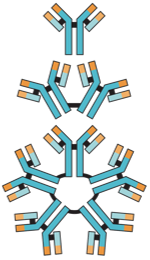immunology wars
may your immune system defend you
Antibodies

Antibodies, also known as immunoglobulins (Ig), are produced by activated B-lymphocytes and can exist circulating in the blood, or bound to the surface of B-lymphocytes as B-cell receptors (BCRs). Each antibody uniquely identifies a specific inflammatory agent and helps to fight inflammation or infection by binding to the threat, neutralising it, blocking its entry into our cells or marking them for destruction by other immune cells. When a B-lymphocyte becomes activated it can become a plasma cell, producing over 1000 antibody molecules per second for a period of several days to help neutralise the threat.

Most antibodies are helpful in clearing a threat, however, on rare occasions antibodies can be produced against substances that are not harmful, such as pollen or dust, which causes allergic responses. In autoimmune diseases, such as rheumatoid artritis, antibodies can be produced against the body's own tissue causing its destruction.

The human immune system can produce 5 different classes, or types, of antibodies. Each of these classes has a slightly different role with in the immune response:
IgG - coats microbes, speeding their destruction by other cells in the immune system.
IgD - remains attached to B cells and plays a key role in initiating early B-cell response.
IgE - natural role to protect against parasitic infections, is also implicated in the symptoms of allergy.
IgA - found in body fluids including tears and saliva to guard the entrances to the body.
IgM - very effective at killing bacteria.
Cells
- Basophils
- Eosinophils
- Mast Cells
- Neutrophils
- Monocytes / Macrophages
- Natural Killer Cells
- Dendritic Cells
- B-Lymphocytes
- T-Lymphocytes
- CD4+ T-Lymphocytes
- CD8+ T-Lymphocytes
- Regulatory T-lymphocytes
- Th17 Lymphocytes
